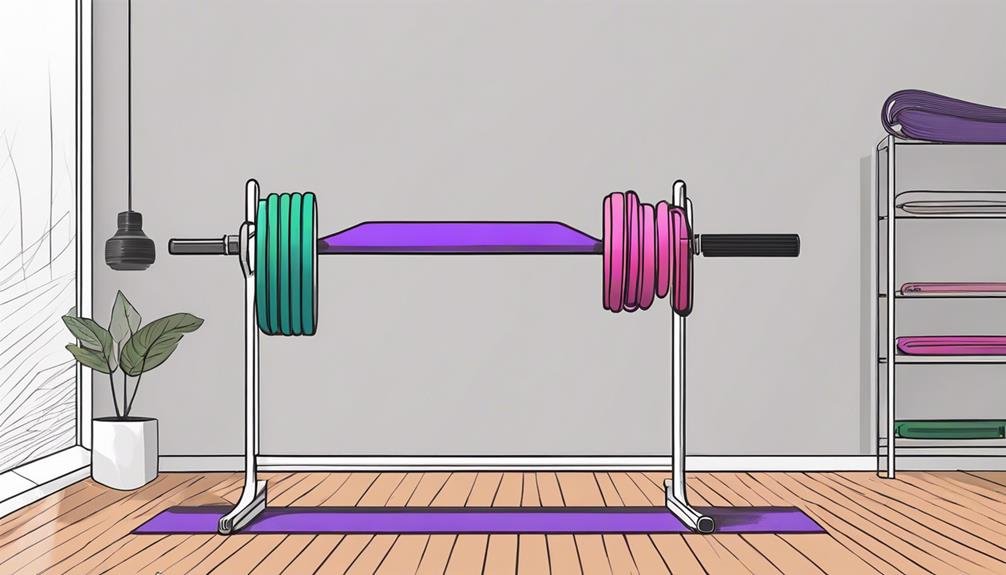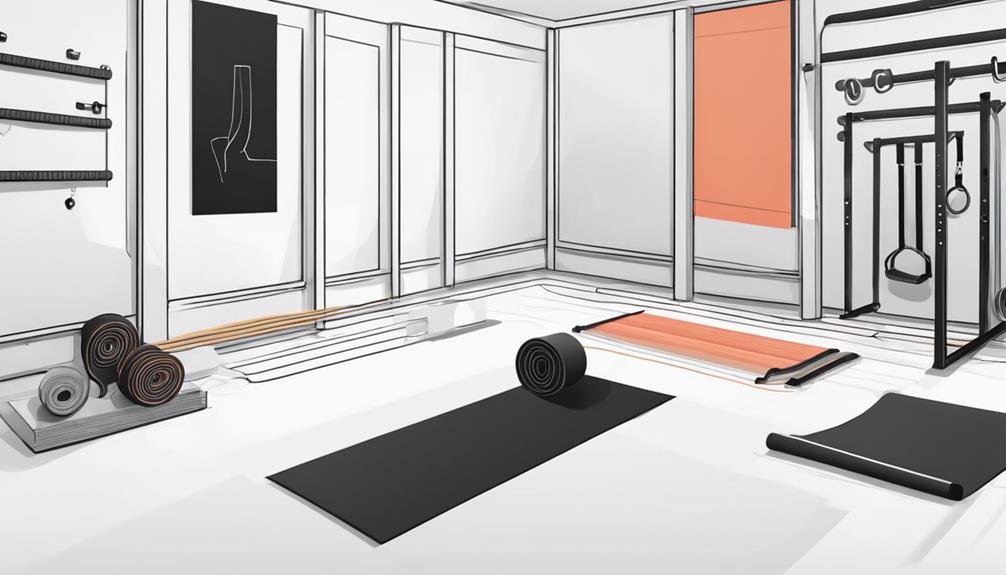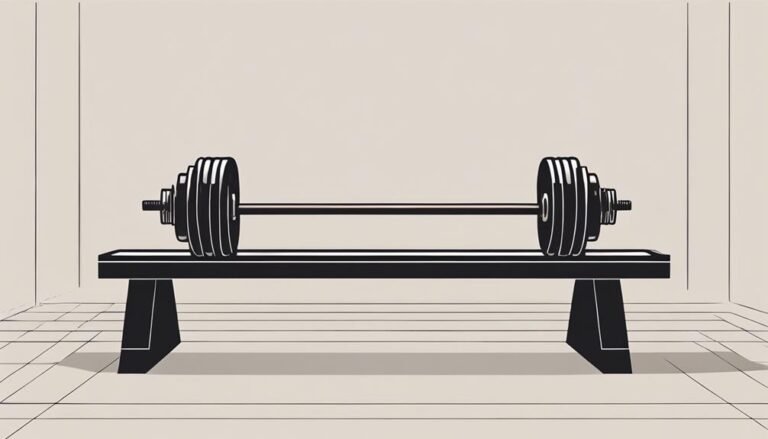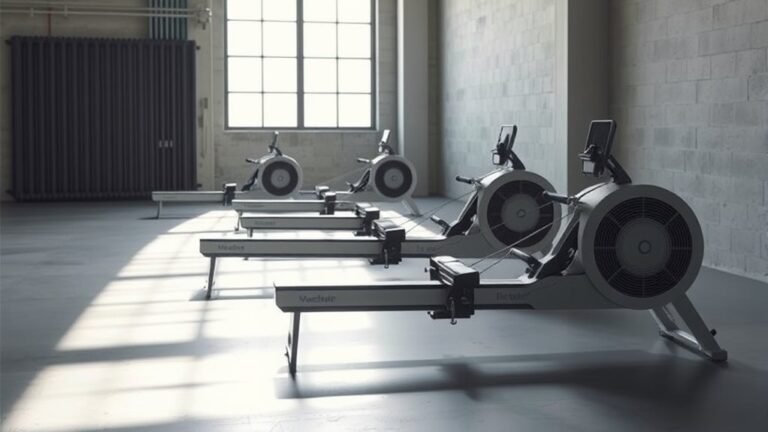10 Best Resistance Band Workouts for Men Over 40
If you're over 40 and looking for effective resistance band workouts, you're in the right place. Resistance bands offer low-impact, versatile strength training that's easy on your joints. Start with chest presses, seated rows, and squats to build core strength. Don't forget exercises like bicep curls and lateral walks for balanced muscle engagement. Focus on three sets of 10-15 reps for each move. Incorporating flexibility stretches enhances your routine, too. Always use controlled movements and proper form to stay safe. Keep going to discover more workouts tailored specifically for your needs!
Key Takeaways
- Resistance band workouts provide a versatile, low-impact option ideal for building strength and flexibility in men over 40.
- Key exercises include Chest Press, Seated Row, Squats, and Bicep Curls for effective strength training.
- Incorporate core strengthening moves like the Seated Row and Banded Plank to enhance stability and balance.
- Lateral Band Walks and Deadlifts target lower body strength without the need for heavy weights.
Benefits of Resistance Band Workouts
Why should you consider resistance band workouts?
They offer a versatile and low-impact way to build strength, improve flexibility, and support joint health, especially for men over 40.
Resistance bands are lightweight and portable, making it easy to incorporate them into your routine at home or on the go.
They provide constant tension throughout your movements, engaging your muscles effectively while minimizing the risk of injury.
Additionally, these workouts can be easily tailored to your fitness level, allowing for gradual progression as you gain strength.
You'll also find that resistance bands enhance your range of motion, promoting better mobility.
With their affordability and simplicity, resistance bands are an excellent choice to maintain your fitness and overall well-being as you age.
Key Exercises for Strength
Incorporating key resistance band exercises into your routine can greatly boost your strength and overall fitness as you age.
Start with the chest press; anchor the band behind you, grasp the handles, and push forward, engaging your chest and triceps.
Next, try the seated row: sit with your legs extended, loop the band around your feet, and pull towards your torso for a solid back workout.
For your legs, perform squats by standing on the band, holding the handles at shoulder height, and bending your knees.
Finally, include bicep curls to target your arms; stand on the band and curl the handles towards your shoulders.
These exercises provide a balanced approach to building strength effectively and safely.
Full-Body Resistance Band Routine

A full-body resistance band routine can enhance your strength training by engaging multiple muscle groups in one efficient workout. This approach not only saves time but also maximizes your effort.
Here are three key exercises to include in your routine:
- Squats with Bands: Stand on the band, hold the handles, and squat while keeping tension on the band to work your legs and core.
- Chest Press: Anchor the band behind you, hold the handles, and press forward to target your chest and triceps.
- Seated Row: Sit with your legs extended, wrap the band around your feet, and pull the handles towards you to strengthen your back and arms.
Incorporate these exercises to build strength and improve overall fitness.
Upper Body Focused Workouts
Focusing on your upper body with resistance band workouts can build strength and improve your overall fitness level effectively.
Incorporate exercises like banded chest presses, rows, and shoulder presses to target key muscle groups.
To do a chest press, anchor the band behind you, hold the ends, and push forward.
For rows, step on the band, pull the handles to your chest, and squeeze your shoulder blades together.
Shoulder presses can be performed by standing on the band and pressing the ends overhead.
Aim for three sets of 10-15 reps for each exercise, adjusting resistance as needed.
These workouts not only enhance muscle tone but also promote joint stability, essential for maintaining mobility as you age.
Lower Body Strength Builders

Building lower body strength with resistance bands can greatly enhance your stability and power, making everyday movements easier as you age.
Resistance bands are versatile and perfect for targeting your legs and glutes without heavy weights.
Here are three effective exercises you can try:
- Squats: Stand on the band with feet shoulder-width apart and hold the handles. Lower your body into a squat, keeping your back straight.
- Lateral Band Walks: Place the band around your legs just above your knees. Step side to side, maintaining tension in the band to engage your outer thighs.
- Deadlifts: Stand on the band, hold the handles, and hinge at your hips to lower your torso while keeping your back flat.
Incorporate these into your routine for impressive lower body gains!
Core Strengthening Exercises
How can you strengthen your core effectively with resistance bands?
Start with the band around your feet while seated; lean back slightly and pull the band towards your chest. This seated row engages your abs and back.
Next, try the standing band twist. Secure the band to a sturdy anchor at waist height, stand sideways, and twist your torso away from the anchor, activating your obliques.
For a more dynamic option, do the banded plank. Loop the band around your back and hold the ends in each hand while in a plank position, adding resistance to your core stability.
Flexibility and Mobility Enhancements

Incorporating flexibility and mobility exercises into your routine can enhance overall performance and reduce the risk of injury, complementing the core strength you've developed with resistance bands.
You don't need to spend hours stretching; just a few targeted movements can make a significant difference.
Here are three essential flexibility and mobility exercises:
- Standing Hamstring Stretch: Stand tall, hinge at your hips, and reach for your toes to stretch your hamstrings.
- Chest Opener: Clasp your hands behind your back and gently lift, opening up your chest and shoulders.
- Hip Flexor Stretch: Lunge forward with one foot, keeping your back leg straight, to stretch the hip flexors effectively.
Tips for Safe Practice
To guarantee a safe and effective workout with resistance bands, always start with a thorough warm-up to prepare your muscles and joints for the exercises ahead.
Use controlled movements and focus on form, as improper technique can lead to injuries. Make sure to choose the appropriate resistance level; you should feel challenged but not strained.
Always inspect your bands for signs of wear or damage before use to avoid breakage during workouts. Gradually increase intensity and volume to allow your body to adapt.
Customizing Your Workout Plan

Customizing your workout plan with resistance bands guarantees that you target your specific fitness goals and accommodate any physical limitations.
To create an effective routine, consider these three key elements:
- Assess Your Goals: Identify whether you want to build strength, increase flexibility, or improve endurance. This focus will shape your exercises.
- Choose the Right Resistance: Start with lighter bands to master movements and gradually increase resistance as you gain strength. This approach helps prevent injury and promotes steady progress.
- Incorporate Variety: Mix different exercises targeting various muscle groups to keep your workouts engaging and prevent plateauing. Include upper body, lower body, and core workouts for a balanced routine.
With these strategies, you'll create a tailored resistance band workout plan that works for you.
Tracking Your Progress
Tracking your progress is essential for staying motivated and ensuring your resistance band workouts are effective.
Start by setting clear, achievable goals, whether it's increasing the number of reps, utilizing heavier bands, or mastering new exercises.
Keep a workout journal or use an app to log your workouts, noting the resistance levels and sets completed.
Regularly assess your strength and flexibility to see how far you've come.
Consider taking progress photos every month to visually track changes in your physique.
Celebrate small victories to maintain motivation, and don't hesitate to adjust your goals as you improve.
Questions
How Often Should Men Over 40 Use Resistance Bands?
You should aim to use resistance bands two to three times a week. This frequency helps build strength and flexibility while allowing your body to recover, ensuring you stay consistent and avoid injury over time.
Can Resistance Band Workouts Help With Joint Pain?
Did you know that nearly 50% of adults experience joint pain? You'll find that resistance band workouts can indeed alleviate discomfort, improving flexibility and strength, allowing you to move more freely and enjoy daily activities again.
What Are the Best Resistance Band Brands for Durability?
When choosing resistance band brands for durability, look for options like TheraBand, Bodylastics, and Black Mountain. They've got strong materials and reliable warranties, ensuring your workouts stay effective and long-lasting without frequent replacements.
Are Resistance Bands Suitable for Beginners?
Resistance bands are like magic fitness tools for beginners. They're versatile, easy to use, and help you build strength without overwhelming you. You'll quickly get comfortable with various exercises as you progress. Enjoy your journey!
How Do Resistance Bands Compare to Free Weights?
Resistance bands offer variable resistance throughout movements, engaging muscles differently than free weights. They're portable and versatile, making them ideal for various workouts. You can enhance flexibility, stability, and strength with both tools effectively.
Conclusion
Incorporating resistance band workouts into your routine can boost your strength and flexibility, especially as you age.
Did you know that studies show men over 40 who engage in regular resistance training can increase their muscle mass by up to 5% per decade?
By focusing on key exercises, customizing your plan, and tracking your progress, you're not just maintaining your fitness—you're enhancing your overall quality of life.
So grab those bands and get started on your journey to better health!







